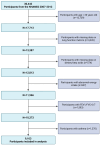Association between dietary fatty acid intake and preserved ratio impaired spirometry in U.S. adults: a population-based cross-sectional study
- PMID: 40808839
- PMCID: PMC12343235
- DOI: 10.3389/fnut.2025.1622795
Association between dietary fatty acid intake and preserved ratio impaired spirometry in U.S. adults: a population-based cross-sectional study
Abstract
Background: Preserved ratio impaired spirometry (PRISm) is increasingly recognized as a clinically relevant but underdiagnosed lung function abnormality. This pulmonary phenotype is clinically significant yet remains insufficiently studied. Although dietary fatty acids are known to have anti-inflammatory and immune-regulating properties, their relationship with PRISm has not been previously explored. This study aimed to evaluate the associations between intake of saturated (SFA), monounsaturated (MUFA), and polyunsaturated fatty acids (PUFA) and the prevalence of PRISm in U.S. adults.
Methods: We conducted a cross-sectional analysis using data from 9,103 adults in the 2007-2012 National Health and Nutrition Examination Survey (NHANES). Dietary intake of SFA, MUFA, and PUFA was assessed from two 24-h dietary recalls. Fatty acid variables were log-transformed and standardized. Logistic regression models were used to estimate odds ratios (ORs) and 95% confidence intervals (CIs) for the associations between fatty acid intake and PRISm, adjusting for sociodemographic, behavioral, and clinical covariates. Nonlinear relationships were examined using restricted cubic splines. A two-sided p-value <0.05 was considered statistically significant.
Results: Among the study population (mean age 45.6 ± 15.8 years; 47.7% male), 1,362 participants (15.0%) exhibited the PRISm phenotype. In models controlling for demographic, lifestyle, and clinical variables, each standard deviation increase in SFA [0.86 (0.75-0.99)] and PUFA [0.88 (0.79-0.99)] intake was associated with a statistically significant reduction in the odds of PRISm. MUFA intake was not significantly related to PRISm. Restricted cubic spline analysis indicated no evidence of non-linearity in these associations. The inverse relationships for SFA and PUFA were also consistent across demographic and clinical subgroups.
Conclusion: Greater consumption of saturated and polyunsaturated fatty acids was associated with a lower prevalence of PRISm in a nationally representative adult population. These associations were consistent across key demographic and clinical subgroups. If confirmed in prospective studies, our findings may inform early dietary strategies to support pulmonary health.
Keywords: NHANES; PRISm; dietary fatty acid; lung function; nutrition.
Copyright © 2025 Liu, Zeng, Zhou, Zheng, Yang and Liao.
Conflict of interest statement
The authors declare that the research was conducted in the absence of any commercial or financial relationships that could be construed as a potential conflict of interest.
Figures





Similar articles
-
A comprehensive investigation of the relationship between dietary fatty acid intake and preserved ratio impaired spirometry: multimethodology based on NHANES.Lipids Health Dis. 2025 Aug 1;24(1):258. doi: 10.1186/s12944-025-02674-8. Lipids Health Dis. 2025. PMID: 40751263 Free PMC article.
-
Prescription of Controlled Substances: Benefits and Risks.2025 Jul 6. In: StatPearls [Internet]. Treasure Island (FL): StatPearls Publishing; 2025 Jan–. 2025 Jul 6. In: StatPearls [Internet]. Treasure Island (FL): StatPearls Publishing; 2025 Jan–. PMID: 30726003 Free Books & Documents.
-
The relationship between flavonols intake and stroke in the elderly: a cross-sectional study from NHANES (2007-2010 and 2017-2018).J Stroke Cerebrovasc Dis. 2025 Aug;34(8):108373. doi: 10.1016/j.jstrokecerebrovasdis.2025.108373. Epub 2025 Jun 7. J Stroke Cerebrovasc Dis. 2025. PMID: 40490174
-
Nutritional interventions for survivors of childhood cancer.Cochrane Database Syst Rev. 2016 Aug 22;2016(8):CD009678. doi: 10.1002/14651858.CD009678.pub2. Cochrane Database Syst Rev. 2016. PMID: 27545902 Free PMC article.
-
Omega-3 fatty acids for depression in adults.Cochrane Database Syst Rev. 2015 Nov 5;2015(11):CD004692. doi: 10.1002/14651858.CD004692.pub4. Cochrane Database Syst Rev. 2015. Update in: Cochrane Database Syst Rev. 2021 Nov 24;11:CD004692. doi: 10.1002/14651858.CD004692.pub5. PMID: 26537796 Free PMC article. Updated.
References
LinkOut - more resources
Full Text Sources

